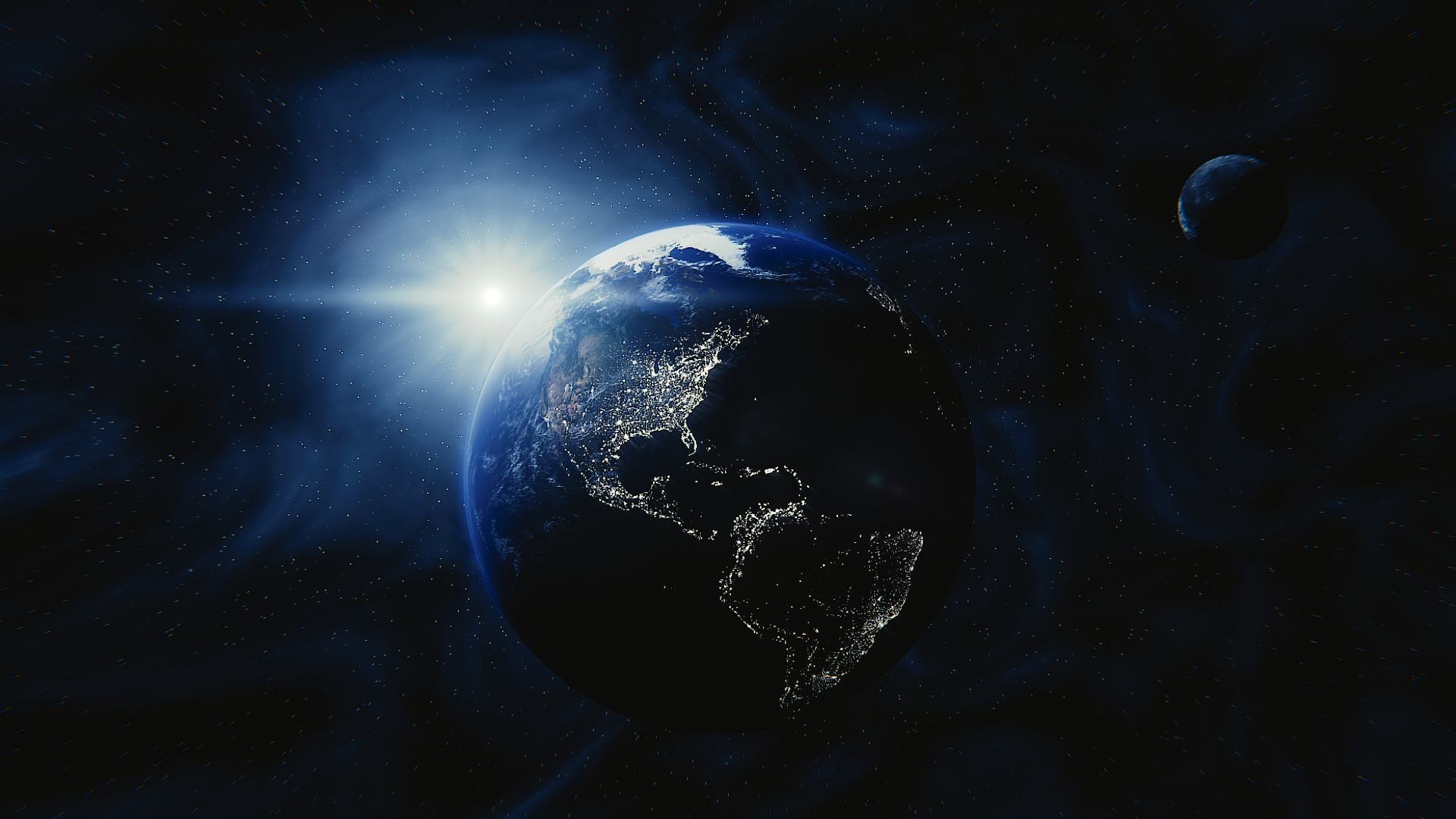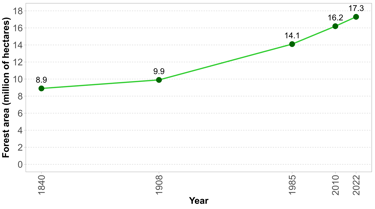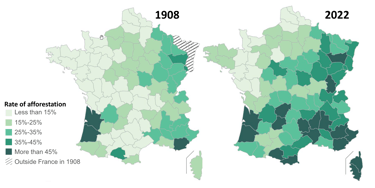
Articles on the Anthropocene
In-depth articles on the Anthropocene
A history of the French forest - Part 1
The long-term history of the French forest as a witness to the millennia-old influence of humans on the Earth's surface
Nowadays, forest covers around a third of the area of mainland France [1]. Far from the imaginary of immutability that is associated with it, this forest has undergone constant variations over the course of history: regression, expansion, changes in the composition of plant communities (tree species, companion plants...) or in the density of the canopy...
These evolutions may have been driven by "natural" forces; for example, the alternation of glacial and interglacial periods determines the surface area that the forest can occupy. However, since the end of the last ice age, they have also been largely driven by humans, who have always had a vital need for forest. In this article, we explore the dynamics of the French forest over the long run, to show how humans have been the main force behind its transformation for millennia.
The French forest is expanding
Contrary to what some might think at first glance, the French forest has been characterized for decades by a spectacular expansion dynamic. Between 1850 and today, the area covered by forest in mainland France has almost doubled (Figure 1) [1]. In less than 40 years (since 1985), it has grown by around 20%, while the standing volume of wood has increased by 55%.
There's never been as much forest as there is today?
Based on the impressive dynamics of forest expansion observed over the last few decades, the idea that there has "never been as much forest as there is today" is sometimes put forward [2, 3, 4]. Is this true? Well, not quite, if not at all. In fact, it all depends on what you mean by "never". It's true that there hasn't been as much forest in France as there is today for several centuries. Nevertheless, the long-term history of the forest shows that, in the distant past, forest cover was much more extensive.
At the end of the last ice age, around 12,000 years ago, a phase of forest reconquest began, with trees being able to colonize the spaces freed up by the retreating ice (Figure 3). The forest then expanded significantly over time, reaching its peak around 7,000 to 5,000 BC, with an estimated surface area of almost 500,000 km2, or just under 90% of the surface area of mainland France.
A historical link between human demography and forest surface
As early as 5000 BC, the mastery of tools and the beginnings of agriculture, accompanied by demographic growth, led to massive land clearance [5]. This dynamics was continued by the Romans and their descendants. In the Middle Ages, land was cleared intensively to further develop agricultural land. Land clearances were encouraged by monastic orders, the Church seeing the forest as a demonic world to be civilized.
The end of the Middle Ages saw a serious demographic crisis, linked in particular to epidemics (the Black Death of 1348) and the Hundred Years' War. The forest's regression was stopped, and forest even began to expand (Figure 3). However, the resumption of demographic growth - with a population far lower than today's - once again led to a sharp contraction in forest area.
To counter this age-old forest decline, Louis XIV decided on the "Great Reformation" of the kingdom's forests, and Colbert's Ordinance was promulgated in 1669. In spite of these political measures, the forest continued to decline as the population grew, leading to an increase in farming and grazing.
In addition, population growth and pre-industrial activity, with its glassworks and forges, meant additional wood requirements. Forest cover thus reached a minimum shortly after the French Revolution, with a surface area of probably less than 90,000 km2, or around 15% of the country's surface area [5].
Figure 1: Changes in forest area in mainland France from 1840 to the present day. Source of data: IGN [1].


This expansion dynamic is widespread: contrary to popular belief of "afforestation with conifers", it concerns both hardwood and softwood species, and can be observed throughout France, although it is particularly marked in the south of the country (Figure 2).


Figure 2: Change in afforestation rate (ratio of forest area to total land area) by department in France between 1908 and 2022. Source of the figure: IGN [1].


Figure 3: Changes in afforestation rate (ratio of forest area to total land area) and human population in France since the end of the last ice age (12,000 years ago). Data sources: For the afforestation rate, data reconstructed from an article by Yves Birot for the period prior to 1840 [5] and the IGN memento for the period 1840-2022 [1]; For human population, data from Our World in Data [6].
The myth of the "Gaule chevelue"
As you will have gathered from the preceding paragraphs, forest area and human population have been closely linked throughout the history of France, where deforestation was already massive several millennia before our era.
This long-standing deforestation dynamic largely undermines the legendary image of a "Gaule chevelue" made up of gigantic forests populated by wild boar-hunting Gauls. In reality, the Gaulish countryside must have resembled the bocage landscapes of western France before agricultural consolidation, with quadrangular fields of 10-15 ares surrounded by hedges to protect crops from wind and animals [7]. Even the Ardennes (northeast France), often fantasized as a land of majestic, impenetrable forests, were dotted with cultivated gaps.
However, Gaul's cultivated land was not sufficient to provide food for the population, and the forests were put to good use for grazing, hunting and gathering various plants and fruits. They were also used to harvest wood, which for millennia had been a fundamental raw material for building houses and making tools, as well as an essential source of energy: for heating, lighting, cooking, and powering kilns in tile factories, glassworks, potteries and the metallurgy used to make weapons [7].
In short, the Gallic era (and earlier times) can be seen as a "proto-Anthropocene": far from matching its current transformative force, human activity was already considerably modifying natural environments, with the mainland France territory of the time corresponding to a space largely "artificialized" by centuries of deforestation and expansion of agricultural land.
References
[1] IGN, Mémento, édition 2023. https://inventaire-forestier.ign.fr/IMG/pdf/memento_2023.pdf
[2] P. Fricot, Erwan Le Méné, président d’EcoTree : « Planter des arbres ne suffit pas », Environnement Magazine, 2023. https://www.environnement-magazine.fr/biodiversite/article/2023/09/29/145955/erwan-mene-president-ecotree-planter-des-arbres-suffit-pas
[3] T. Eñaut Helou, « À l’heure du dérèglement climatique, les forestiers sont plus que jamais indispensables », Le Figaro, 2023. https://www.lefigaro.fr/vox/societe/a-l-heure-du-dereglement-climatique-les-forestiers-sont-plus-que-jamais-indispensables-20230809
[4] E. De La Chesnais et Service Infographie, « La forêt sauvage gagne du terrain en France », Le Figaro, 2019. https://www.lefigaro.fr/actualite-france/en-france-la-foret-sauvage-profite-des-friches-pour-croitre-20190529
[5] Y. Birot, Les forêts et les hommes : quelles co-évolutions ?, in La Forêt et le Bois en France en 100 questions, 2015. https://www.academie-foret-bois.fr/chapitres/chapitre-1/fiche-1-05/
[6] H. Ritchie et al., Population Growth, Our World in Data. https://ourworldindata.org/population-growth
[7] M. Chalvet, Une histoire de la forêt. Seuil, 2011.
Conclusion
The Anthropocene is the time during which humans are the main force driving change on the Earth's surface. Since forests cover a third of the Earth's land surface, it's hardly surprising that humans have become the main force driving forest change.
On the other hand, the fact that human's predominant influence on the French forest dates back several thousand years BC may come as more of a surprise. This immemorial influence ties in with the idea that defining a starting point for the Anthropocene is no easy task, and that humans didn't wait for capitalism, the atomic bomb or the Internet to modify their environment on a large scale.
The first part of this article shows that a key fact in the long-term history of the French forest is the close link between the size of the human population and forest area: as the human population increases, forest cover decreases. In the second part of this article, we will explore the more recent period of the French forest, which is characterized by a break in this historical link. We will investigate the causes of this historical breakage and look at the new threats facing French forests, to show humans have not finished shaping the French forest - quite the contrary.
Henri Cuny
